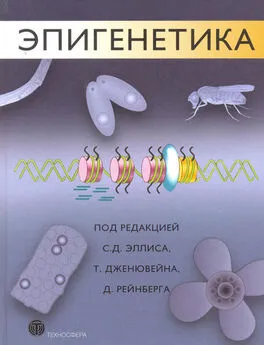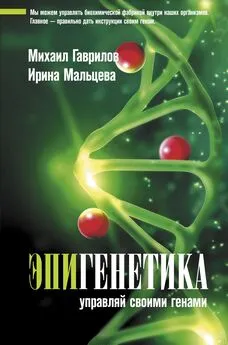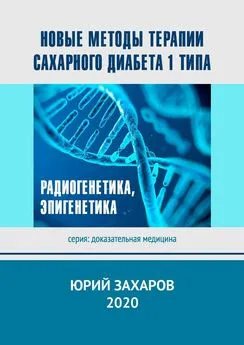Чарльз Эллис - Эпигенетика
- Название:Эпигенетика
- Автор:
- Жанр:
- Издательство:Техносфера
- Год:2010
- Город:Москва
- ISBN:978-5-94836-257-1
- Рейтинг:
- Избранное:Добавить в избранное
-
Отзывы:
-
Ваша оценка:
Чарльз Эллис - Эпигенетика краткое содержание
Книга ярко и наглядно повествует о новой науке общебиологического значения — эпигенетике, а также об ее отдельных областях. В издании представлено описание разных эпигенетических сигналов и механизмов их реализации, а также собственно феномен, история и концепции эпигенетики, ее отдельные механизмы и пути реализации эпигенетических сигналов в клетке. Авторы различных глав данной книги — ведущие в мире специалисты в области эпигенетики, являющиеся, как правило, и основоположниками ее отдельных областей.
Издание будет полезно широкому кругу читателей, интересующихся коренными проблемами живого мира, сущности жизни и молекулярных механизмов ее проявления.
По формирующейся традиции современной российской научной литературы, оригинальное русскоязычное печатное издание неопрятно переведено, отвратительно вычитано и содержит большое количество ошибок, начиная с обложки. Чарльз Дэвид Эллис указан как С. Д. Эллис.
Эпигенетика - читать онлайн бесплатно полную версию (весь текст целиком)
Интервал:
Закладка:
Хотя все это было представлено в виде последовательного рассказа, более правильным был бы взгляд на эти события, как на ряд параллельных и перекрывающихся попыток определить и объяснить эпигенетические явления. Определение термина «эпигенетика» изменилось, но вопросы относительно механизмов развития, поставленные более ранними поколениями ученых, остались прежними. Современная эпигенетика все еще обращается к этим центральным вопросам. Семьдесят лет прошло с тех пор, как Меллер описал явление, называемое сейчас эффектом положения мозаичного типа. Доставляет удовольствие проследить этот медленный прогресс от наблюдения фенотипов, через элегантные генетические исследования, к современному анализу и решению проблем на молекулярном уровне. Вместе с этими знаниями пришло понимание того, что в действительности эпигенетические механизмы могут отвечать за значительную часть фенотипа сложных организмов. Как нередко случается, наблюдение, показавшееся вначале хотя и интересным, но, возможно, маргинальным по отношению к главным проблемам, оказывается центральным, хотя для осознания этого может понадобиться много времени.
Литература
Ahmad K. and HenikoffS. 2002. The histone variant H3. 3 marks active chromatin by replication-independent nucleosome assembly. Mol. Cell. 9: 1191–1200.
Allfrey V. G., Faulkner R., and Mirsky A. E. 1964. Acetylation and methylation of histones and their possible role in the regulation of RNA synthesis. Proc. Natl. Acad. Sci. 51:786–794.
Avery O. T., MacLeod CM., and McCarty M. 1944. Studies on the chemical nature of the substance inducing transformation of pneumococcal types. J. Exp. Med. 79:137–158.
Bannister A., Zegerman P., Partridge J., Miska E., Thomas J., Allshire R., and Kouzarides T. 2001. Selective recognition of methylated lysine 9 on histone H3 by the HP1 chromo domain. Nature 410:120–124.
Beisson J. and Sonnebom T. M. 1965. Cytoplasmic inheritance of the organization of the cell cortex in Paramecium aurelia. Proc. Natl. Acad. Sci. 53:275–282.
Bell A. C. and Felsenfeld G. 2000. Methylation of a CTCF-dependent boundary controls imprinted expression of the lgf2 gene. Nature 405:482–485.
Bird A. P. 1978. Use of restriction enzymes to study eukaryotic DNA methylation. II. The symmetry of methylated sites supports semi-conservative copying of the methylation pattern. J. Mol. Biol. 118: 49–60.
Bird A. P. and Southern E. M. 1978. Use of restriction enzymes to study eukaryotic DNA methylation. I. The methylation pattern in nbosomal DNA from Xenopus laevis. J. Mol. Biol. 118:27–47.
Bonner J., Huang R. C., and Gilden R. V. 1963. Chromosomally directed protein synthesis. Proc. Natl. Acad. Sci. 50:893–900.
Briggs R. and King T. J. 1952. Transplantation of living nuclei from blastula cells into enucleated frogs’ eggs. Proc. Natl. Acad. Sci. 38:455–463.
Brownell J. E., Zhou J., Ranalli T, Kobayashi R., Edmondson D. G., Roth S. Y., and Allis C. D. 1996. Tetrahymena histone acetyltransferase A: A homolog to yeast Gcn5p linking histone acetylation to gene activation. Cell 84:843–851.
Cattanach B. M. and Kirk M. 1985. Differential activity ol maternally and paternally derived chromosome regions in mice. Nature 315:496–498.
Cedar H. and Felsenfeld G. 1973. Transcription of chromatin in vitro J. Mol. Biol. 77:237–254.
Chess A., Simon I., Cedar H., and Axel R. 1994. Allelic inactivation regulates olfactory receptor gene expression. Cell 78:823–834.
Clark R. J. and Felsenfeld G. 1971. Structure of chromatin. Nat. New Biol. 229:101–106.
Doskocil J. and Sorm F. 1962. Distribution of 5-methylcytosine in pyrimidine sequences of deoxyribonucleic acids. Biochim. Biophys. Acta 55:953–959.
Durrin L. K., Mann R. K., Kayne P. S., and Grunstein M. 1991. Yeast histone H4 N-terminal sequence is required for promoter activation in vivo. Cell 65: 1023–1031.
Grimes G. W. and Aufderheide K. J. 1991. Cellular aspects of pattern formation: The problem of assembly. Monogr. Dev. Biol. 22: 1-94.
Hall I. M., Shankaranarayana C. D., Noma K., Ayoub N., Cohen A., and Grewal S. I. 2002. Establishment and maintenance of a heterochromatin domain. Science 297: 2215–2218.
Hannah A. 1951 Localization and function of heterochromatin in Drosophila melanogaster. Adv. Genet. 4: 87-125.
Hark A. T., Schoenherr C. J., Katz D. J., Ingram R. S., Levorse J. M., andTilghman S. M. 2000. CTCF mediates methylation-sensitive enhancer-blocking activity at the H19/Igf2 locus. Nature 405:486–489.
Hershey A. D. and Chase M. 1952. Independent functions of viral protein and nucleic acid in growth of bacteriophage. J. Gen. Physiol. 36: 39–56.
Holliday R. and Pugh J. E. 1975. DNA modification mechanisms and gene activity during development. Science 187:226–232.
Jablonka E. and Lamb M. J. 1995. Epigenetic inheritance and evolution: The Lamarckian dimension Oxford University Press, New York, p. 82.
Jorgensen R. 1993. The germinal inheritance of epigenetic information in plants. Philos. Trans. R. Soc. Lond. B Biol. Sci. 339:173–181.
Komberg R. D. and Thomas J. 0. 1974. Chromatin structure; oligomers of the histones. Science 184:865–868.
Lachner M., O’Carroll D., Rea S., Mechtler K., and Jenuwein T. 2001. Methylation of histone H3 lysine 9 creates a binding site for HP1 proteins. Nature 410:116–120.
Laskey R. A. and Gurdon J. B. 1970. Genetic content of adult somatic cells tested by nuclear transplantation from cultured cells. Nature 228:1332–1334.
Luger K., Mader A. W., Richmond R. K., Sargent D. F., and Richmond T. J. 1997. Crystal structure of the nucleosome core particle at 2. 8 Eresolution. Nature 389:251–260.
Lyon M. F. 1961. Gene action in the X-chromosome of the mouse. Nature 190:372–373.
McClintock B. 1965. The control of gene action in maize. Brookhaven Symp. Biol. 18:162–184.
McKittnck E., Gafken P. R., Ahmad K., and HenikoffS. 2004. Histone H3. 3 is enriched in covalent modifications associated with active chromatin. Proc. Natl. Acad. Sci. 101:1525–1530.
Morgan T. 1911. An attempt to analyze the constitution of the chromosomes on the basis of sex-linked inheritance in Drosophila. J. Exp. Zool. 11: 365–414. Muller H. J. 1930. Types of visible variations induced by X-rays in Drosophila. J. Genet. 22: 299–334.
Nakayama J., Rice J. C., Strahl B. D., Allis C. D., and Grewal S. I. 2001. Role of histone H3 lysine 9 methylation in epigenetic control of heterochromatin assembly. Science 292: 110–113.
Novick A. and Weiner M. 1957. Enzyme induction as an all-or-none phenomenon. Proc. Natl. Acad. Sci. 43:553–566.
Ohno S., Kaplan W. D., and Kinosita R. 1959. Formatipn of the sex chromatin by a single X-chromosome in liver cells of Rattus norvegicus. Exp. Cell Res. 18: 415–418.
Paul J. and Gilmour R. S. 1968. Organ-specific restriction of transcription in mammalian chromatin. J. Mol. Biol. 34: 305–316.
Pazin M. J., Kamakaka R. T., and Kadonaga J. T. 1994. ATP-dependent nucleosome reconfiguration and transcriptional activation from preassembled chromatin templates. Science 266: 2007–2011.
Peterson C. L. and Herskowitz 1. 1992. Characterization of the yeast SWI1, SWI2, and SWI3 genes, which encode a global activator of transcription. Cell 68: 573–583.
Ptashne M. 1992. A genetic switch: Phage X and higher organisms, 2 ndedition. Blackwell Science, Maiden, Massachusetts and Cell Press, Cambridge, Massachusetts.
Richmond T. J. Finch J. T., Rushton B., Rhodes D., and Klug A. 1984. Structure of the nucleosome core particle at 7 E resolution. Nature 311: 532–537.
Riggs A. D. 1975. X inactivation, differentiation, and DNA methylation. Cytogenet. Cell Genet. 14:9-25.
Riggs A. D. and Porter T. N. 1996. Overview of epigenetic mechanisms. In Epigenetic mechanisms of gene regulation (ed. V. E. A. Russo et al.), pp. 29–45. Cold Spring Harbor Laboratory Press, Cold Spring Harbor, New York.
Riggs A. D., Martienssen R. A., and Russo V. E. A. 1996. Introduction. In Epigenetic mechanisms of gene regulation (ed. V. E. A. Russo et al.), pp. 1–4. Cold Spring Harbor Laboratory Press, Cold Spring Harbor, New York.
Shykind B. M., Rohani S. C., O’Donnell S., Nemes A., Mendelsohn M., Sun Y., Axel R., and Bamea G. 2004. Gene switching and the stability of odorant receptor gene choice. Cell 117: 801-815.
Stam M., Belele C, Dorweiler J., and Chandler V. 2002. Differential chromatin structure with a tandem array 100 kb upstream of the maize bl locus is associated with paramutation. Genes Dev. 16:1906–1918.
Stedman E. and Stedman E. 1950. Cell specificity of histones Nature 166:780–781.
Sturtevant A. 1913. The linear arrangement of six sex-linked factors in Drosophila, as shown by their mode of association. J. Exp. Zool. 14:43–59.
Tsukiyama T. and Wu C. 1995. Purification and properties of an ATP-dependent nucleosome remodeling factor. Cell 83:1011–1020.
Waddington C. H. 1953. Epigenetics and evolution. Symp. Soc. Exp. Biol. 7: 186–199.
Wallis J. W., Hereford L., and Grunstein M. 1980. Histone H2B genes of yeast encode two different proteins. Cell 22:799–805.
Wysocka J., Swigut T., Milne T. Dou Y., Zhang X., Burlingame A., Roeder R., Brivanlou A., and Allis CD. 2005. WDR5 associates with histone H3 methylated at K4 and is essential for H3 K4 methylation and vertebrate development. Cell 121:859–872.
Глава 3. Общий обзор и основные понятия
Интервал:
Закладка:








